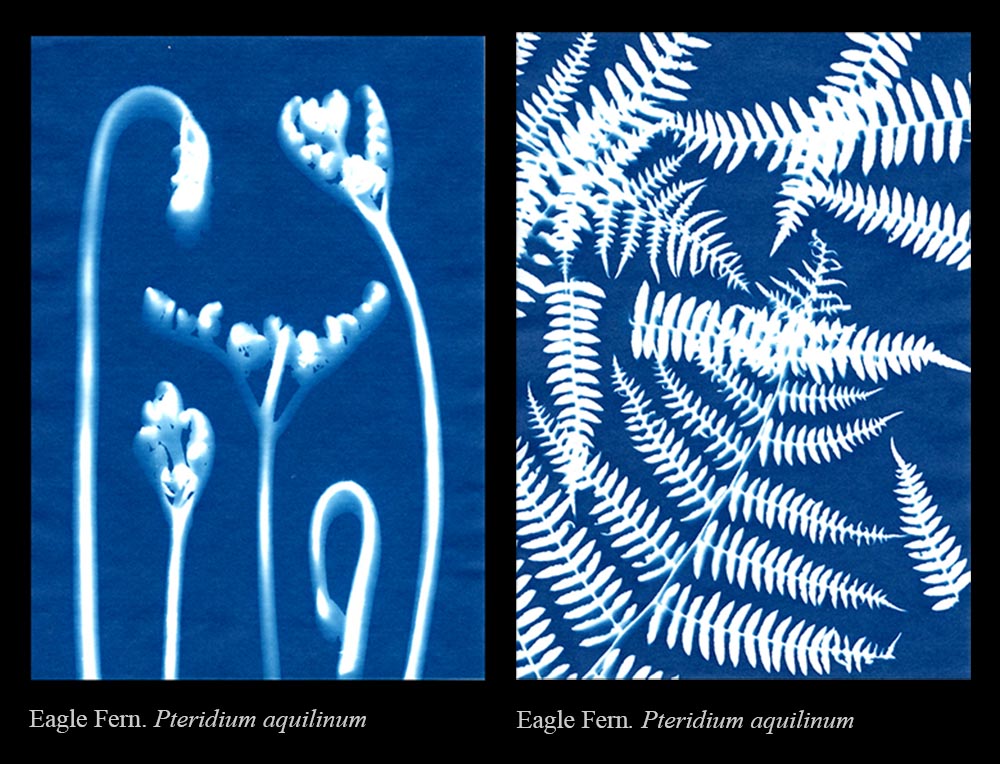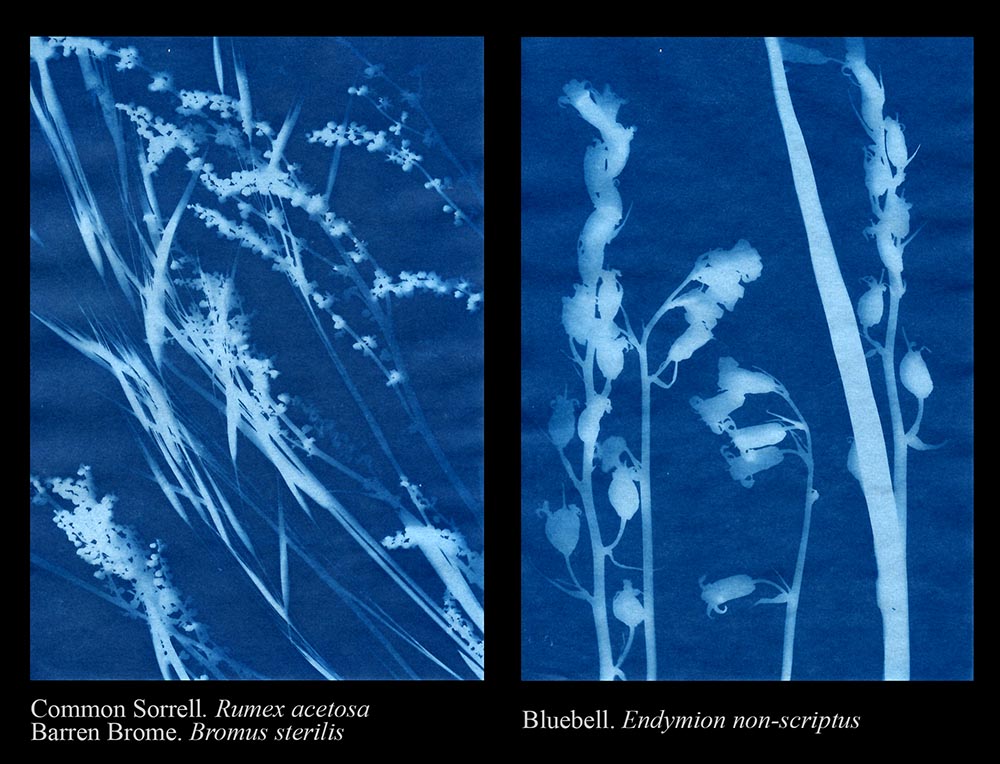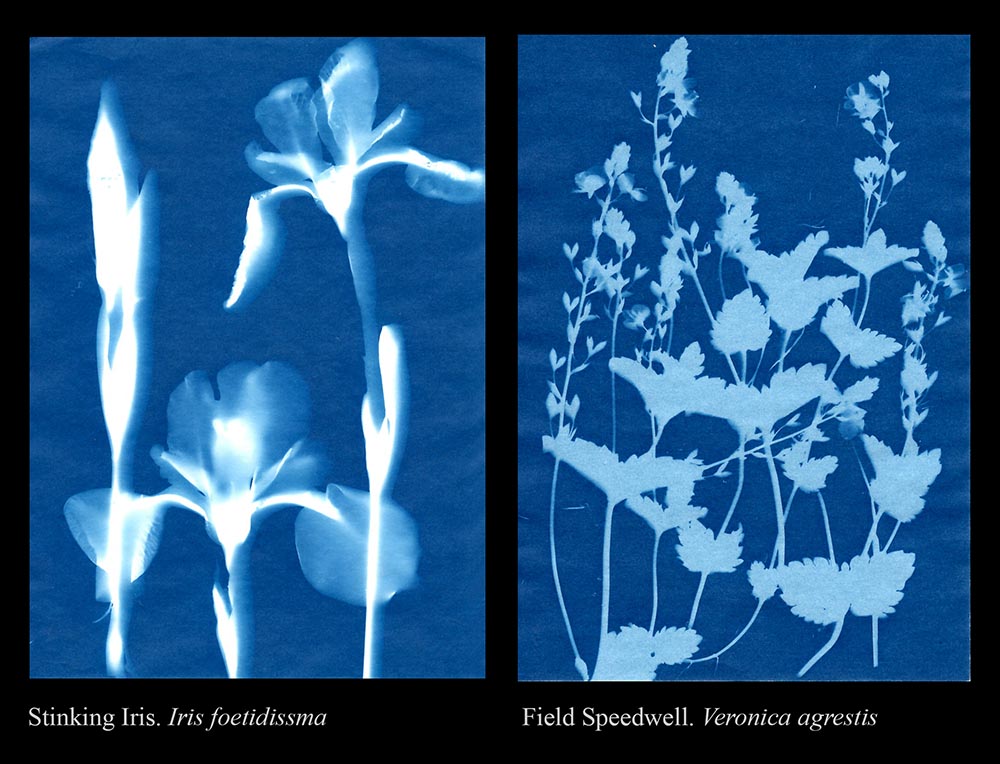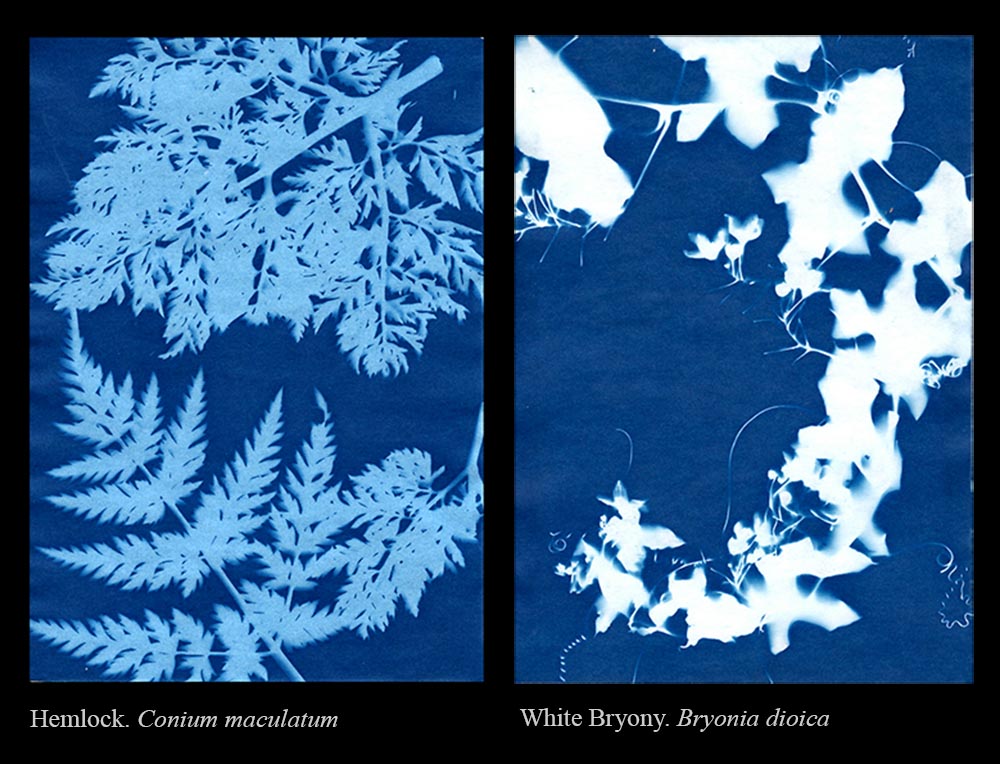




I’m often out and about with my digital camera, photographing whatever takes my fancy, and my computer is filled with folders of photographs that I promise myself I will print one day, some day. This spring, I wondered if I could find an alternative and more physically direct way of visually recording the progress of the trees and plants as they attained their fullest leaf and flower. Although the new technologies of smart phones, tablets and laptops allow instant and virtually unlimited visual gratification of a certain kind, I wanted to find a way of working that would bring me into closer contact with the plants themselves, something that would require me to pay fuller attention to the structural elements of photography - the stuff from which photography is actually made - light conditions, weathers, atmospherics and the passage of time. Researching online, I discovered cyanotypes and some of the inspirational exponents of early cyanotypy.
In short, cyanotypes are photographic images which are formed by exposing sensitised paper to light. The image, always white, seems to float in a mysterious ghostly aura on an intense Prussian blue background. The genealogy of the technique stretches back over two centuries, crosscutting various fields of knowledge and expertise - astronomy, chemistry, botany, drawing and photography. Cyanotypes are the original form of blueprints. In the final decade of the 18th century, Thomas Wedgewood (1771-1805) - born of the famous blue pottery dynasty - experimented with light‑sensitive materials to produce photograms, one of the very earliest forms of photographs. In 1834 the scientist and pioneer of photography, Henry Fox-Talbot (1800 - 1877), developed the ‘photogenic drawing’ technique by experimenting with objects such as lace fragments which were laid directly onto light‑sensitive paper. By 1842 the polymath astronomer Sir John Herschel (1792 - 1871) had invented the cyanotype process.
During the 1840s and 1850s, two of the process’s most interesting and prolific practitioners were women. Using Fox-Talbot’s method and Herschel’s process, Cecilia Glaisher (1828 - 1892) created a compendium of fern cyanotypes, The British Ferns - Photographed from Nature by Mrs Glaisher. Between 1843 and 1853 Anna Atkins (1799 - 1871) produced her three volume work Photographs of British Algae: Cyanotype Impressions. Aided by her assistant Anne Dixon (1799 -1864), Atkins also produced Cyanotypes of British and Foreign Ferns and Cyanotypes of British and Foreign Flowering Plants and Ferns. The classic blue background colour of the prints is especially apt for both algae (seaweed) studies and terrestrial plant studies. It can be read interchangeably as either watery or airy in character, a medium in which weightless specimens appear to float as though gracefully suspended in zero gravity conditions.
Atkins and Glaisher were well-connected to important members of the Victorian scientific elite. Both had family and social contacts within innovative professional circles where accurate observation and precise recording of natural phenomena were highly valued. Glaisher’s father was an assistant astronomical observer at the Royal Greenwich Observatory and her husband, a Fellow of the Royal Society, held the position of President in several other eminent scientific societies throughout the second half of the 19th century. Atkins learned about photography directly from Fox-Talbot and she was a friend of Herschel who introduced her to his cyanotype process.
In my searches I found just one reproduction of a photograph of Cecilia and one of Anna. Despite bearing the beribboned burden of Victorian fashion, the two women have an air of great self-possession, extreme seriousness. Both portraits capture the authoritative and determined demeanour of these early photographers.
Beginning my own experiments with the technique that these precursors became so expert at, I quickly discovered that the sparse instructions on my pack of light-sensitive paper were grossly over-simplified. The process was nowhere near as ‘easy’ as these promised. But as I began to get a feel for the right kind of light and the correct exposure times, I wondered what guidance Cecilia, Anna and Anne might have offered if they were looking over my shoulder. Working with plants, paper, light and water, I fancied that I could hear the first true cyanotype makers issuing knowledgeable instruction. I imagined hearing their cultivated Victorian voices, sometimes speaking with great composure one at a time and sometimes over-excitedly, all at once. Some of the following is what I found out by experimenting and some of it is what I think that, between them, Anna and Anne and Cecilia might have advised.
To make a cyanotype, you will need the following resources and equipment: a strong source of ultra violet light such as that emitted by the thermo-nuclear explosions of a nearby star, fresh water, a watch with a second hand, a supply of sheets of light-sensitive paper which have been prepared with a coating of ferric ammonium citrate and potassium ferricyanide. A small pane of plate glass, a piece of board, and a sheet of black card all of the same size will be useful. You should organise ready access to a darkened room and to an adjacent outdoor workspace. Your chosen subjects must be collected in advance. Ideally these will be small-scale objects such as textile fragments, threads, buttons, feathers, leaves - anything with a distinctive and interesting shape.
You must be prepared to work with the constraints of the weather and with the movements of heavenly bodies, choosing a bright and cloudless day, preferably a still one. Be ready to work when the sun is getting high in the sky, but do not try to work when it is at its zenith because too much light will quickly spoil your images. Beginning indoors, in the darkened room, take a sheet of the sensitised blue paper and lay it on the piece of board. Working quickly, arrange some of your samples on the paper. Avoid hesitation, second thoughts or re-arranging, because once out of its black protective covering, the bright blue paper will begin to react. If the day is breezy, cover your arrangement with the pane of glass. Cover the pane of glass with the sheet of black card. Take the prepared arrangement outside. Look at your watch. Remove the black card and expose your arrangement to the sun’s light. Watch the second hand travelling around the face of your watch. Start counting the seconds. Concentrate.
Look at your arrangement, focusing first on the colours and shapes of the objects laid out on their sky blue background. Look at your watch. Look again at your arrangement. Take pleasure in the shapes, in the relationships between the samples and the spaces around them. Consider negative and positive space. While you do this, time will seem to slow right down giving you the chance to notice the shapes of the very tiniest shadows being cast onto the blue page.
Look at your watch. Maintain concentration. Observe the progress of the seconds. Be aware of the sun’s progress across the clear blue backdrop of the sky. Count the seconds. In the spaces between the seconds, you might think of how light is crossing the 93 million mile distance between the sun and your samples. The light in which you are now working will have begun its journey from the sun around eight and a half minutes ago. Look back at the samples. Examine the extent of the minute spaces between the samples and the shadows they cast. Take careful note of how the paper’s blue is reacting, quickly fading, paling almost to white. Be ready for the moment when you realise that the little shadows cast by your specimens have transformed, assumed a substance, a substantiality that is something more than, other than, shadow itself. Look at your watch. Count the final seconds down. See how, now, the paper is practically white and both the objects and their shadows have left their exact blue imprint on the bleached page.
As the final second arrives and pauses and passes, cover the arrangement with black card. Retreat immediately from the sunlight and take the black-covered arrangement indoors. Dazzled by the glare and surprised by what you have just seen, you will struggle to re-acclimatise your vision to conditions of darkness. For a few moments you will fumble, bedazzled, semi-sighted, semi-blinded as you remove the black card, and the glass pane. Shake the arrangement of samples off the paper. Their work is done. See how the whitened sheet is crisply marked with dark blue silhouette-like images of your samples. Lose no time. Submerge the sheet into a shallow dish of water. Rinse and agitate the sheet. Refresh the water. Keep rinsing. Watch how the image changes. You will see a magical colour reversal taking place, the paper’s original blue gradually reasserting itself and the dark blue silhouette shapes transmuting, melting from dark to paler, clouded blue. The colour shift is as subtle and fluent as changes in sky-colour itself. Watch as the colour passes slowly from palest bluebell, to delphinium colour, then to Wedgewood blue and finally to deep Prussian blue.
Lay the wet cyanotype between layers of dry paper. Cover it with a heavy board. Leave it undisturbed. Allow the curing process to begin. Start the process all over again: lay out new samples, make a different arrangement, count out more seconds, more moments of sunlight. Keep moving new sheets of paper outdoors and indoors, into sunlight and out of it, into water and out of it. Get a print production line going. Be methodical. Be fastidious. Enjoy the mechanics of repetition. Stack up the exposed papers. Be patient. Let them dry and develop.
Let a few hours elapse. Wait until the sun starts to slide down behind the trees in the west. Wait this long before you reveal your cyanotypes. The wait is worthwhile because what you have worked to capture is a uniquely special image, a permanent imprint of a momentarily moving shadow, a record of some minute thing which was briefly interposed between the four and a half billion year old surfaces of a revolving planet and its sun.
Cyanotypes are both more than and different from two dimensional pictures. Although they resemble photographic
negatives, they are not exactly photographs as we have come to know them, nor stencils, nor x-rays or scans.
Being more substantial than shadow and more shadowy than substance, they partially resemble all of these
things. Hovering somewhere between likeness and light, every cyanotype is an individual and unrepeatable record of the brief presence of a
temporary arrangement, a transitory fragment of existence.They are recordings of time, moments drawn out with the medium of light.




Kim Crowder. June 2018